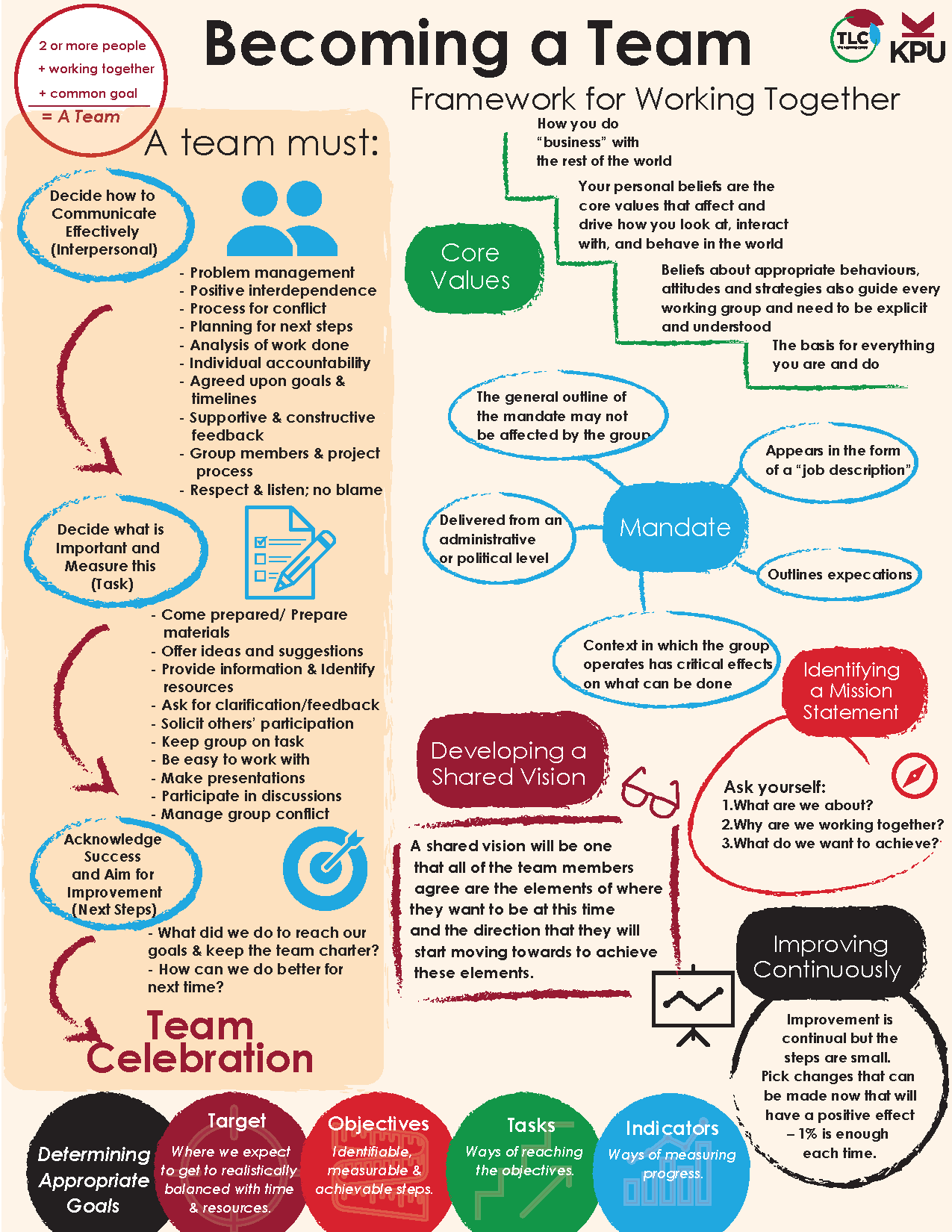2.5 Make Commitments that Support Teamwork
In this module, you will review some key concepts about becoming an effective team, presented within the infographic below.
If you prefer a more traditional reading experience, scroll below the graphic for the full text. You can also download a copy of the infographic for your reference.
Image Credit: Rawia Inaim
Becoming a Team
A Team is two or more people; working together; on a Common Goal (or goals). Groups become Teams if the common goals are clear and attention is paid to both interpersonal and task functions.
The Team must Decide how to Communicate Effectively (Interpersonal)
Each Team must set up their own guidelines for good communication and a Team Charter. Through discussion and negotiation the members choose the items that are most important for their clear communication as a Team. These often include commitment to:
- Respect and Listen to others
- Not blame (work hard on the problem, not on the person)
- Group members and Project process
- Supportive and Constructive Feedback
- Agreed upon Goals and Clear Timelines
- Positive interdependence (sink or swim together)
- Individual Accountability (say what you will do and do it)
- Analysis of work done and Planning for next steps
- Process for conflict and Problem Management
The Team must Decide what is Important and Measure This (Task)
Early in the formation of the group, the members must decide what will be measured in the process. These items are generally critical to success and for the group to become an Effective Team. A team that has succeeded shares the following characteristics. Its members:
- Came prepared
- Offered ideas and suggestions, Provided information
- Asked for clarification/feedback
- Identified resources
- Solicited others’ participation
- Kept group on task
- Was easy to work with
- Prepared materials
- Made presentation
- Participated in discussions
- Managed group conflict
The Team must Acknowledge Success and Aim for Improvement
What have we done (individually and collectively) to meet our goals and keep the Team Charter?
How can we do better for next time? (Next steps)
The Team Celebrates!
Celebrate what you have accomplished and then refocus your efforts for greater success!
Framework for Working Together
Core Values
Your personal beliefs are the core values that affect and drive how you look at the world, your behaviour in the world and your interaction with others. They are how you do “business” with the rest of the world. In other words, they are the basis for everything that you are and do. These beliefs about appropriate behaviours, attitudes and strategies also guide every working group and need to be explicit and understood.
Mandate
It is useful to know what you are expected to do in a group situation. This is often delivered or requested from an administrative or political level and appears in the form of a “job description”. The group which is mandated may not be able to effect the general outline of the mandate. The context in which the group operates has critical effects on what can be done.
Identifying a Mission Statement
A mission statement embodies the group’s current purpose and intent and answers (within the mandate of the group) questions such as: What are we about? Why are we working together? What do we want to achieve? It describes the business that you are in. This may be a statement developed by the whole organization or it may be more localized in a department, program, class, work group or individually. It gives direction to actions. Without knowing your mission, you may not be able to get started.
Developing Shared Vision
Vision is a future oriented statement of a group’s purpose in a task, project or work team. Having the members shared a vision that aligns with their personal values and aspirations is a solid basis for production. Time spent at the beginning in dreaming and discussing what the final result will be is time well spent. If it is not possible to have a shared vision of the end product and the goals and milestones that must be reached then the team may also have difficulty identifying whether they have accomplished their purpose.
Sometimes, when the project is open ended or ongoing, the final product cannot be totally “visioned” at the beginning. A shared vision will then be one that all of the team members agree are the elements of where they want to get at this time and the direction that they will start moving towards to achieve these elements.
Visions should be revisited and refined over time. If the team is not heading in the same direction, then it may not get anywhere.
Determining Appropriate Goals
What are the individual tasks and goals that will build to making your vision manifest? Goals lead towards the realization of the vision. It is important to develop appropriate goals, make them explicit and share an understanding of each one.
Goals have:
- Targets – where we expect to get to realistically balanced with time and resources.
- Objectives – identifiable, measurable and achievable steps.
- Tasks – ways of reaching the objectives.
- Indicators – ways of measuring progress.
Like our vision statement, goals need to be realigned with reality on a regular basis. Evaluation and adjustment drive this process.
Improving Continuously
Knowing where you are going and how you intend to get there is a good start. The final step is continuous improvement. Planning, implementation, and verification are tools for analysis and change as the process unfolds. Improvement is continual but the steps are small. Pick changes that can be made now that will have a positive effect – 1% is enough each time.


